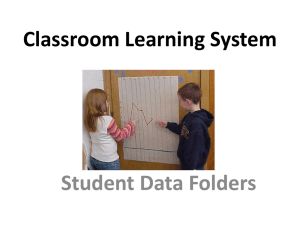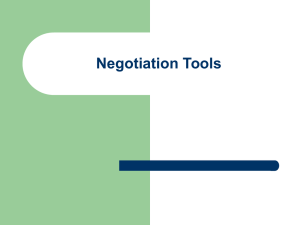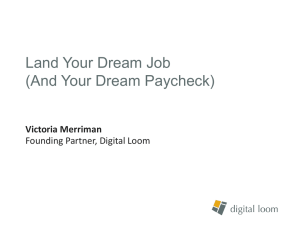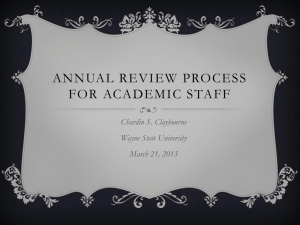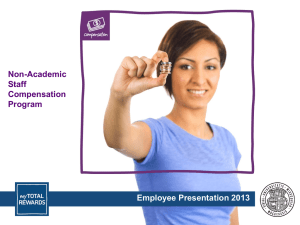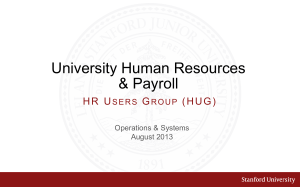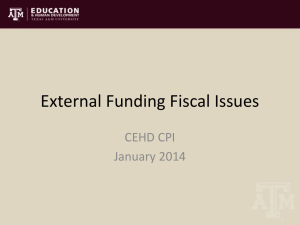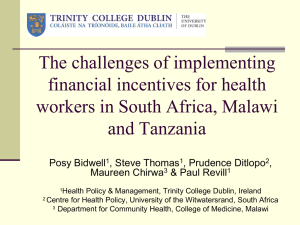Best Practices - Vice President for Finance and Administration
advertisement
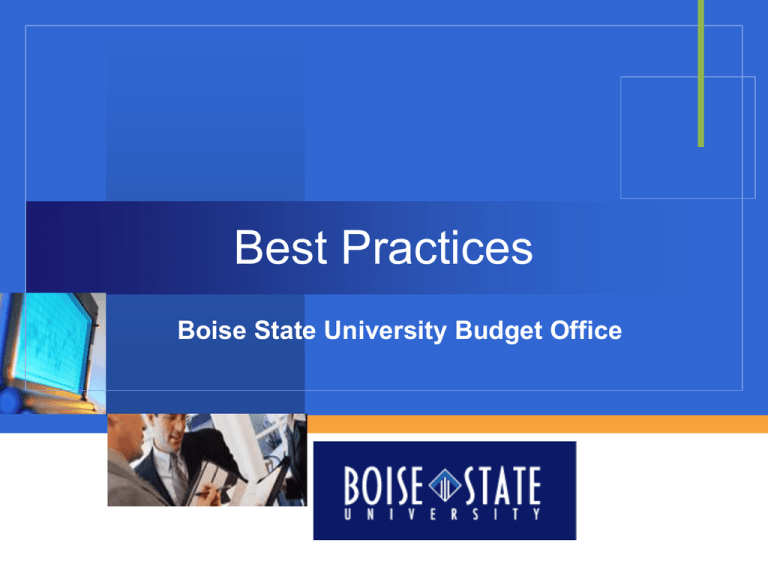
Best Practices Boise State University Budget Office Company LOGO Goals for Training 1. Understand Basic Budget Building 2. How to Monitor OE, Travel & Capital Budgets 3. How to Monitor Payroll Budgets 4. Understand End of Year Processes For Profit vs. Government For Profit Government Revenue – Expenses = Net Income Resources Received = Resources Used Maximize Profit Efficient & Effective Use of Resources Boise State University Financial Reporting Fiscal Year FY 2008 July 1, 2007 To June 30, 2008 Program Type Department Account Associated with Department 10 Digit Alpha-Numeric 6 Digit Numeric General description of activity 909A100001 Asset Liability Revenue Expense Fund Balance Fiscal Year 12-Months July 1 to June 30 FY 2008: July 1, 2007 – June 30, 2008 Program Types / Activity Type Program 01: Instruction Program 04: Research Program 06: Public Service Program 07: Library Program 08: Student Services Program 09: Physical Plant Program 10: Institutional Support Program 11: Academic Support Program 12: Auxiliary Enterprises (Athletics) Program 13: Scholarships Program Types / Activity Type Department Anatomy of the Department ID Biology Format: 3-1-6 Alpha Numeric 006 A 100001 Department identifier Fund Source A = Appropriated L = Local G = Grant 1 = Main Campus 2 = BSU West Section/Unit Identifier Accounts 6 Digit Numeric “Buckets” 3***** = Revenue 4***** = Personnel Costs 5***** = OE & Travel (53****) 6***** = Capital 9***** = Fund Balance Budget Rollup Accounts 410000 Regular Salary 411000 Part-Time/Irregular Salary 412000 Student Salary 420000 Fringe Benefits 500000 Operating/Other Expenses 530000 Travel 600000 Capital Outlay Types of Financial Statements Income Statement GL Department Detail Report Balance Sheet Etc. Users of our Financial Statements Departments Deans / VP’s / Provost / President State Board of Education Governor / Legislature Lending institutions Auditors Uses of Financial Statements Track progress towards goals Compare Actual with Plan/Budget Communicate Modify behavior Assess financial condition Assist in evaluating efficiency and effectiveness Why do we have Budgets? Control spending Monitor progress & modify spending Communicate Required Kinds of Budgets Appropriated General Fund (taxes) $80 million Budget Tuition $47 million Budget Local & Auxiliary Other Student Fees User Fees F&A Transfers from Foundation $26 million Local Budget $61 million Auxiliary Budget ***A****** Departments ***L****** Departments Appropriated Budget Process BSU Budget Process MAR: JFAC & SBOE sets Budget MAR: Local Budget Templates MAY: BSU sets department budgets JULY: Budget effective DEC: Annual Planning Documents AUG: Submit Budget Request to SBOE Local Budgets Budget = a plan or estimate Most common meaning for business Budget is not a guarantee No budget transfers Annual budget preparation: March – May Separate budget book Look at the bigger picture ** ** Think of: Fund Balance = Spending Authority Why Budget Local Departments? Required to submit Local Budgets to the State Board of Education (For FY08 864 budgets sent out, 648 returned 75%) Estimate activity Ensure strategic plans are met Make better planning decisions Gives you something to compare current activity against How does a Local Budget work with the Fund Balance? Fund Balance 10,000 Budget Salary OE 5,000 5,000 How does a Local Budget work with the Fund Balance? Fund Balance 10,000 (3,000) Budget Salary OE 5,000 5,000 (3,000) How does a Local Budget work with the Fund Balance? Fund Balance 10,000 (3,000) 7,000 Budget Salary OE 5,000 5,000 (3,000) 2,000 5,000 Auxiliary Budgets Auxiliary Enterprises are essentially selfsupporting per SBOE policy Annual budget preparation: March - April Information for budget preparation Projected enrollment Salary and payroll expense Utilities Administrative Service Charge Separate budget book Auxiliary Budget Overview 16 Auxiliary Enterprise Departments FY08 Revenue = $61,315,648 FY08 Expense = $61,260,842 FY08 Total Employee FTE = 357.85 Auxiliary Budget Revenue AUXILIARY REVENUE BY CATEGORY OTHER REVENUE 3.4% ADVERTISING & PROMOTIONS 2.6% APPROPRIATED 3.9% FACILITY RENTAL 2.9% STUDENT FEES 16.6% PRIVATE GIFTS 6.6% SALES & SERVICE 49.2% TICKET SALES & EVENTS 14.8% Appropriated Budget Annual Planning Documents Request additional budget for upcoming fiscal year. Used to plan for the next years budget request Planning Communicate Approved New Budget is communicated to department through VP or Provost Appropriated Budget Book Distribution Lists $$ support from State and from Students Lists permanent budget for each appropriated department One-time vs. Permanent Budget Permanent transfers increase or decrease the next years original budget (base) as well as this years budget One-time transfers only effect the current year’s budget Budget Transfers Allowable Budget Transfers Clearing Budget Errors One error holds up the entire journal entry Budget Transfer Form Appropriated Only Correct signatures Plan ahead – remaining fiscal year Not just one pay period at a time Monitoring OE, Travel & Capital Reports Department Detail Report Department Summary Report Appropriated Budget Summary Budget Overview DDR Query & Pivot Table Monitoring OE, Travel & Capital DDR Query & Pivot Table On-line instructions: http://finad.boisestate.edu/aa_home.htm Pros and Cons of using DDR Query Additional entry information Entry signs are ‘reversed’ No budget information Examples: Single DeptID – 12 months side-by-side Single DeptID – 3 Years side-by-side Multiple DeptIDs – side-by-side Monitoring OE, Travel & Capital Local & Auxiliary Fund Balance What to look for on reports No deficits in fund balance Budget What to look for on reports No budget transfers Except for: Auxiliary, computer labs, & a very few others Monitoring OE, Travel & Capital Appropriated Budget What to look for No deficits in budget Allowable Budget Transfers One-time vs. Permanent Timing of transfers Monitoring OE, Travel & Capital Tracking – Folders and Spreadsheets Folders for Open Payments Pending Invoices Pending P-Card Pending Deposits Posted Expenses Posted Revenues When picking an account Be Specific, Reasonable & Consistent Examples: Non-employee travel is OE Folders - Example Folders I’m going to purchase MS Project with my PCard. Cost is about $100. Folders Memo: Acct: 557000 Desktop Software I’m going to purchase MS Project with my P-Card. Cost is about $100. Folders Match Memos to P-Card “Statement” Memo: P-Card “Statement”: $107.59 Office Max Code to 557000 Desktop Software Folders Place in Pending P-Card Folder Memo: P-Card “Statement”: $107.59 Office Max Code to 557000 Desktop Software Folders Place in Pending P-Card Folder Memo & P-Card “Statement” Folders Match P-Card Statement to PeopleSoft Department Detail Report: 500000 OE 557000 Desktop Software Memo & P-Card “Statement” P-Card Wargo 107.59 Folders File in Posted Expenses Folder Department Detail Report: 500000 OE 557000 Desktop Software Memo & P-Card Statement P-Card Wargo 107.59 Folders File in Posted Expenses Folder – Keep 5 years Detail Report P-Card Statement Memos Folders ? ? Department Detail Report: 500000 OE ? 571020 Minor Tools Home Depot $456.78 DDR query. Call AP (if source document is AP) or Accounting to get more information. Folders Invoice Copy $345.67 Office Solutions Department Detail Report: ? Call AP (if the source document is AP) or Accounting to get more information. Reconciliation Workbook Advantage of folders: Tracking expenses from your office to PeopleSoft Example Advantage of Workbook Tracking permanent vs. one-time budget Monitoring Payroll Reports & Tools Payroll Expense Distribution Report Example Payroll query from Business Manager Budget Position Action Request (BPARs) Main focus is on the position Submit BPAR if requesting permanent new position Must have APPROVED funding Permanent Budget (transfer if Appropriated) Approved Supplemental Funding Request (SFR) form if funded by an appropriated department Other reasons for submitting BPARs Academic Areas Must have Department Chair, Dean & Provost signatures before submission to the Budget Office Non-Academic Areas Must have Director & Vice President signatures Employment Action Forms (EAFs) Main focus is on the employee Submit EAF for reappointment if: funded by grant for temp employee, change in salary, term, title Importance of submitting EAFs in a timely manner If late, creates payroll corrections & could delay first paycheck Effective Dates Contract Dates/Working Dates Prorated Salaries Prorated Salaries Employees working less than 12 months Example Who Funds Salary Changes? Faculty & Professional Classified Appropriated Salary Savings What is Salary Savings? Salary savings occurs when there is a vacancy in a permanent PCN that is funded by an appropriated department Appropriated Salary Savings Items needed for salary savings request Budget Book GL Detail Budget Salary Ledger Query (provided by your Business Manager) Pivot Table Example Department Salary Summary by PCN Template (will be provided by the Budget Office upon request) Request for Use of Institutional Salary Savings Form Has to be directly related to a PCN Timing of contracts can impact salary savings Appropriated Salary Savings How do I figure out the amount of the salary savings? Department Salary Summary by PCN Template Request for Use of Institutional Salary Savings Will be reviewed by Budget Office End of Year Processes Carryforward Sweep Timing Permanent Budget for payroll (July Payroll Errors) Behind the Scenes Budget Transfers STARS Cutoff Additional Training Opportunities Budget & Accounting Drop-in Sessions Tue October 16, 2007 9am Tue November 20, 2007 9am PeopleSoft Training October 10, 2007 9am – noon Call Suzy White x 6-2543 Let’s Talk – Account Codes October 24 11am


